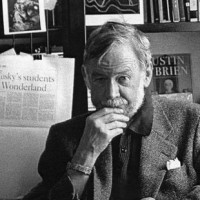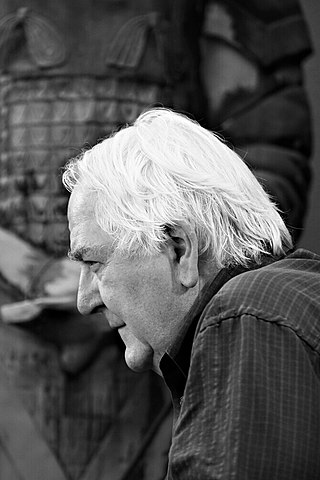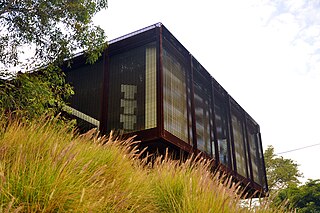Sean Godsell (born 9 September 1960) is an Australian architect.
Sean Godsell (born 9 September 1960) is an Australian architect.
Godsell was born in Melbourne, Australia, the son of David Godsell, also an architect. In his early years he lived in Beaumaris and attended Kostka Hall a preparatory school to Xavier College where he completed his secondary education. He later studied at the University of Melbourne, graduating in 1984. He also undertook postgraduate study at RMIT. From 1986 to 1988 he worked in the London office of Sir Denys Lasdun, returning to Australia in 1989.
In 1980 and 1981, Godsell played for St Kilda in the Victorian Football League. He made two VFL appearance and kicked two goals. [1]
His work has been published in the world's leading Architectural journals including Architectural Review (UK) Architectural Record (USA) Domus (Italy) A+U (Japan) Casabella (Italy) GA Houses (Japan) Detail (Germany) Le Moniteur (France) and Architect (Portugal).
In July 2002 the influential English design magazine Wallpaper listed him as one of ten people destined to 'change the way we live'. He was the only Australian and the only Architect in the group.
He has lectured in the US, UK, China, Japan, India, France, Italy and New Zealand as well as across Australia. He was a keynote speaker at the Alvar Aalto symposium in Finland in July 2006.
In July 2003 he received a Citation from the President of the American Institute of Architects for his work for the homeless. His Future Shack prototype was exhibited from May to October 2004 at the Smithsonian Institution's Cooper Hewitt Design Museum in New York. In the same year the Italian publisher Electa published the monograph Sean Godsell: Works and Projects. Time Magazine named him in the 'Who's Who -The New Contemporaries' section of their 2005 Style and Design supplement. He was the only Australian and the only Architect in the group of seven eminent designers.
In July 2013 he was visiting professor at Iuav University of Venice and delivered the UNESCO chair open lecture in Mantova, Italy.
He has received numerous local and international awards. In 2006 he received the Victorian Premier's Design Award and the RAIA Robin Boyd Award and in 2007 he received the Cappochin residential architecture award in Italy and a Chicago Athenaeum award in the USA – all for St Andrews Beach House on the Mornington Peninsula.
In 2008 he was recipient of his second AIA Record Houses Award for Excellence in the US for Glenburn House. In 2008 architectural historian Kenneth Frampton nominated him for the inaugural BSI Swiss Architecture Award for architects under the age of 50 and his work was exhibited as part of the Milan Triennale and Venice Biennale in the same year.
In 2010 the prototype of the RMIT Design Hub façade was exhibited in Gallery MA in Tokyo before being transported in 2011 to its permanent home at the Victoria and Albert Museum in London. In 2012 he was shortlisted to design the new Australian Pavilion in Venice. In 2013 he received the RAIA Victorian Architecture Medal and William Wardell Awards for the RMIT Design Hub and the Harold Desbrowe Annear award for the Edward St House.
In 2022 Australian Institute of Architects awarded its highest honour, the Gold Medal, to 'master craftsman' Sean Godsell. At the National Prizes announcement the jury commended Godsell's body of work describing it as demonstrating “an extraordinary commitment to excellence in design, detail and resolution".
Denton Corker Marshall is an international architecture practice based in Melbourne, Australia.

Dr Norman Kingwell Day is an architect, educator, and writer.

Edmond and Corrigan is an Australian architectural firm based in Melbourne, Victoria, founded in the late 1970s by partners Maggie Edmond and Peter Corrigan, the firm's principals. The practice's work, both built and written, has been widely associated with the emergence of architectural postmodernism in Australia, an interest in suburbia and a search for an Australian architectural identity. Peter Corrigan taught design studios at RMIT University for over 30 years, until his death in December 2016.

Peter Russell Corrigan was an Australian architect and was involved in the completion of works in stage and set design.

Peter McIntyre is a Melbourne based Australian architect and educator.
Neil Clerehan was an Australian architect and architectural writer.
Kevin Borland was an Australian post-war Architect. Over his career his works evolved from an International Modernist stance into a Regionalist aesthetic for which he became most recognized. Many of his significant works were composed of raw materials and considered ‘Brutalist’ typifying Borland’s renowned motto ‘architecture is not for the faint-hearted’. Borland died in 2000 leaving a legacy of work throughout Victoria, New South Wales and Tasmania.

Dr. Graeme Cecil Gunn AM was an Australian architect and former Dean of the Faculty of Architecture at RMIT.
Wood Marsh Architecture, styled Wood | Marsh Architecture, is a Melbourne-based Australian architectural practice founded by Roger Wood and Randal Marsh in 1983.
Nicholas Phillip Murcutt was an Australian architect.
Philip Harmer is an Australian architect. He graduated from the University of Melbourne with a bachelor's degree in Architecture, and became a Fellow of the Royal Australian Institute of Architects (RAIA). Harmer has a strong appreciation for sculptural forms and spaces that are powerfully shaped or wrought; thus, his works display the cleverness of how certain materials and details are used to represent his individual persona.
Williams Boag, now known under the name WILLIAMS BOAG architects (WBa), is a Melbourne-based architectural practice that describes itself as a socially responsible design practice with a focus on modernist principles. Aesthetically Williams Boag's designs most closely resemble that of contemporary Scandinavian architecture. Williams Boag is a company with a single director, Peter Williams.
Kerstin Thompson is an Australian architect, born in Melbourne in 1965. She is the principal of Kerstin Thompson Architects (KTA), a Melbourne-based architecture, landscape and urban design practice with projects in Australia and New Zealand. She is also Professor of Design at the School of Architecture at Victoria University of Wellington, New Zealand, and adjunct professor at RMIT University and Monash University.

Kew House is an architecturally notable house designed by Australian architect Sean Godsell as his own family home, built in 1996–1997 and located at 8 Hodgson Street in Kew, Victoria, Australia.
Corbett Marshall Lyon is an Australian architect, art patron and academic who lives and works in Melbourne. He is a founding director of Melbourne architectural firm Lyons. With partners Carey Lyon, Cameron Lyon, Neil Appleton, Adrian Stanic and James Wilson he has designed many award-winning institutional and public buildings in Australia.

The RMIT Design Hub is a research, archive, exhibition, and studio space of the Royal Melbourne Institute of Technology in Melbourne, Australia located on the historic Carlton & United Breweries site.

Eli (Elisabetta) Giannini AM is an Australian architect and director of MGS Architects in Melbourne. Giannini completed her architectural undergraduate studies at RMIT University in 1983 and Master of Design (Thesis) in 1903, entitled ‘Metro-scape’. Soon after her undergraduate studies in 1989, she joined MGS Architects with Robert McGauran and Mun Soon. In 2002 she was selected as President of the Victorian Chapter of the Australian Institute of Architects, a position occupied until 2004.
Kristin Green is the director of the Australian architecture practice Kristin Green Associates architecture based in Melbourne, Australia.
Dimity Reed is an architect, urbanist and academic. She has been involved in government advisory roles, as well as writing for both The Sun and The Age newspapers.

The Victorian Architecture Medal is the highest honour awarded annually by the Victoria Chapter of the Australian Institute of Architects (AIA) and has been awarded 38 consecutive times since 1987. The Medal was originally known as the ‘Street Architecture Medal’ introduced by the Royal Victorian Institute of Architects (RVIA) in 1929 as an award for the design of a building of exceptional merit. Buildings were judged on their "urban propriety and architectural etiquette; the building had to front a street, road, square or court" and with a requirement of being publicly accessible, thereby excluding residential and private commissions.